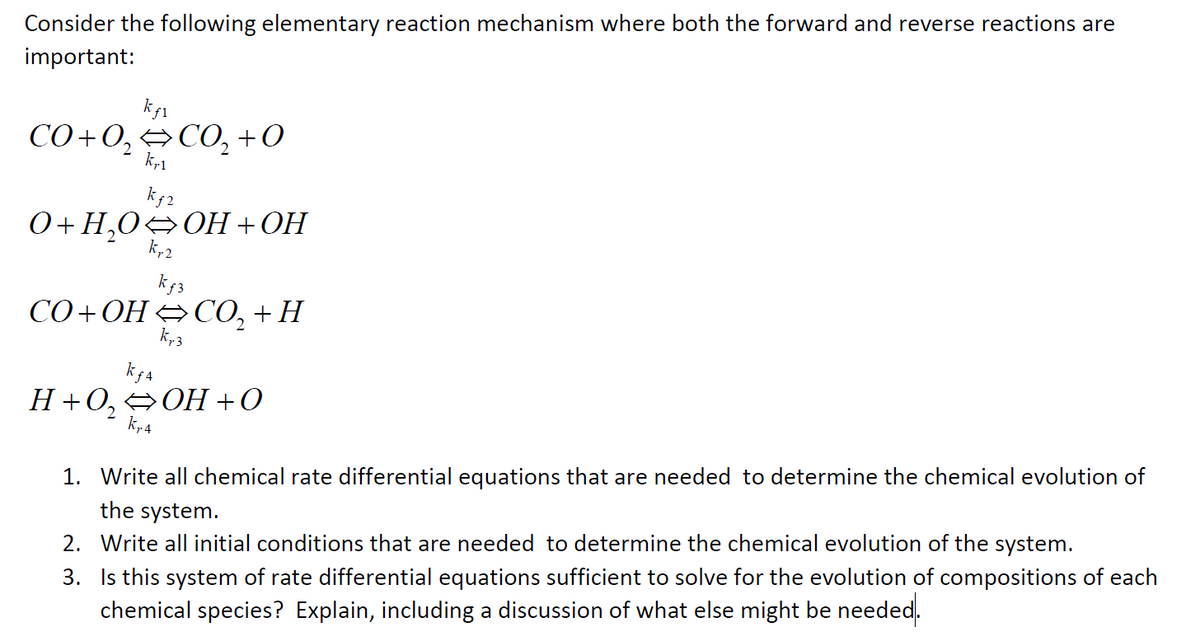Consider the following elementary reaction mechanism where both the forward and reverse reactions are important: kf1 CO+O₂ CO₂ +0 kr1 O+H₂O OH+OH kf2 kr2 Kf3 CO+OHCO₂ + H k,3 2 kƒ4 H+0₂ ⇒OH+O kr 4 1. Write all chemical rate differential equations that are needed to determine the chemical evolution of the system. Write all initial conditions that are needed to determine the chemical evolution of the system. 2. 3. Is this system of rate differential equations sufficient to solve for the evolution of compositions of each chemical species? Explain, including a discussion of what else might be needed.
Consider the following elementary reaction mechanism where both the forward and reverse reactions are important: kf1 CO+O₂ CO₂ +0 kr1 O+H₂O OH+OH kf2 kr2 Kf3 CO+OHCO₂ + H k,3 2 kƒ4 H+0₂ ⇒OH+O kr 4 1. Write all chemical rate differential equations that are needed to determine the chemical evolution of the system. Write all initial conditions that are needed to determine the chemical evolution of the system. 2. 3. Is this system of rate differential equations sufficient to solve for the evolution of compositions of each chemical species? Explain, including a discussion of what else might be needed.
Chemistry: Principles and Practice
3rd Edition
ISBN:9780534420123
Author:Daniel L. Reger, Scott R. Goode, David W. Ball, Edward Mercer
Publisher:Daniel L. Reger, Scott R. Goode, David W. Ball, Edward Mercer
Chapter13: Chemical Kinetics
Section: Chapter Questions
Problem 13.50QE
Related questions
Question

Transcribed Image Text:Consider the following elementary reaction mechanism where both the forward and reverse reactions are
important:
kf1
CO+O₂ CO₂ +0
2
kr1
O+H₂O OH+OH
kƒ2
kr2
kƒ3
CO+OH=CO,+H
k₁.3
kf4
H+0,⇒OH+O
kr 4
1. Write all chemical rate differential equations that are needed to determine the chemical evolution of
the system.
2. Write all initial conditions that are needed to determine the chemical evolution of the system.
3. Is this system of rate differential equations sufficient to solve for the evolution of compositions of each
chemical species? Explain, including a discussion of what else might be needed.
Expert Solution
This question has been solved!
Explore an expertly crafted, step-by-step solution for a thorough understanding of key concepts.
This is a popular solution!
Trending now
This is a popular solution!
Step by step
Solved in 2 steps

Knowledge Booster
Learn more about
Need a deep-dive on the concept behind this application? Look no further. Learn more about this topic, chemistry and related others by exploring similar questions and additional content below.Recommended textbooks for you

Chemistry: Principles and Practice
Chemistry
ISBN:
9780534420123
Author:
Daniel L. Reger, Scott R. Goode, David W. Ball, Edward Mercer
Publisher:
Cengage Learning


Chemistry by OpenStax (2015-05-04)
Chemistry
ISBN:
9781938168390
Author:
Klaus Theopold, Richard H Langley, Paul Flowers, William R. Robinson, Mark Blaser
Publisher:
OpenStax

Chemistry: Principles and Practice
Chemistry
ISBN:
9780534420123
Author:
Daniel L. Reger, Scott R. Goode, David W. Ball, Edward Mercer
Publisher:
Cengage Learning


Chemistry by OpenStax (2015-05-04)
Chemistry
ISBN:
9781938168390
Author:
Klaus Theopold, Richard H Langley, Paul Flowers, William R. Robinson, Mark Blaser
Publisher:
OpenStax

Chemistry
Chemistry
ISBN:
9781305957404
Author:
Steven S. Zumdahl, Susan A. Zumdahl, Donald J. DeCoste
Publisher:
Cengage Learning

Chemistry: An Atoms First Approach
Chemistry
ISBN:
9781305079243
Author:
Steven S. Zumdahl, Susan A. Zumdahl
Publisher:
Cengage Learning
